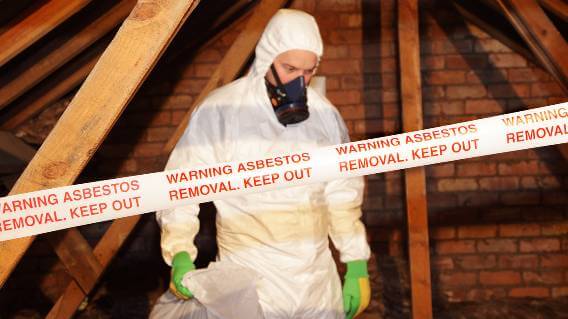United Kingdom Proposes 40-Year Asbestos Removal Deadline
Asbestos Exposure & BansWritten by Tim Povtak | Edited By Walter Pacheco

The United Kingdom’s Work and Pensions Committee has proposed a 40-year timeline to complete the regulated removal of all long-standing legacy asbestos from public and commercial buildings, potentially setting a new standard for other nations to follow.
Its proposal was recently delivered to the House of Commons with a recommendation that the government and Health and Safety Executive incorporate the findings into their approach to asbestos management.
The U.K. already is one of more than 60 nations in the world to have banned asbestos, but none have passed this type of regulation for legacy asbestos, which has been killing people worldwide for decades.
This latest directive could be groundbreaking.
“Asbestos is one of the great workplace tragedies of modern times,” Stephen Timms, a member of the British Parliament and chair of the Work and Pensions Committee, said about the proposal. “While the extreme exposures of the late 20th century are now behind us, the risk from asbestos remains real.”
Britain Aims for ‘Net-Zero’ Asbestos Levels
Asbestos is a naturally occurring mineral that was once used in many industries due to its ability to resist heat and strengthen most anything with which it was mixed.
Unfortunately, it is also toxic. Asbestos becomes a health threat if the microscopic fibers are inhaled or ingested, causing a variety of serious problems that can include asbestosis, lung cancer and malignant mesothelioma.
According to the recent report, there are an estimated 300,000 nondomestic buildings in the U.K. that contain some level of asbestos. The report estimated that 5,000 people died in Britain from asbestos exposure in 2019.
The goal, according to the report, is a “net-zero” level of asbestos in the U.K., obtained through its total removal in a safer, strictly regulated and more manageable process.
UK Plan Outlines Path to Eradicating Asbestos
Asbestos was first banned in the U.K. in 1999, and subsequent legislation through the Control of Asbestos Regulations Act there helped improve safety measures surrounding legacy asbestos.
Among the directives within this recent proposal are:
- Sponsor improvements in how information on asbestos in buildings is used and communicated.
- Develop a framework for the measurement of current asbestos exposure in nondomestic buildings.
- Work with local government agencies to review and share evidence related to routine environmental air monitoring of asbestos in those buildings.
- Improve inspection and enforcement activity targeting compliance with the Control of Asbestos Regulations governmental agency.
- Require accredited and licensed asbestos removal contractors, adhering to strict protocol, to be used for all projects.
- Develop a strategic plan that adheres to the 40-year window in which asbestos is removed from all buildings to achieve the net-zero result.
“Setting a clear deadline of 40 years for the removal of asbestos from nondomestic buildings will help to focus minds,” Timms said. “This is no time for laissez-faire.”
Nonoccupational Asbestos Exposure Rates Rising
Levels of asbestos exposure attributed to certain occupations, such as construction, shipbuilding and mining, have continued to drop significantly. However, the nonoccupational level of exposure is rising as commercial construction with asbestos from decades ago deteriorates with age and requires significant renovation or demolition.
The Work and Pensions Committee’s report calls for a “cross government and system-wide strategy for the long-term removal of asbestos.”
It also calls for stricter enforcement of current asbestos removal procedures, which often are done by individual businesses not adhering to standards.
“The drive towards retrofitting of buildings to meet net-zero aspirations means the risk of asbestos exposure will only escalate in the coming decades,” Timms said. “Falling back on regulations which devolve responsibility to individual building owners and maintenance managers will not be sufficient to protect people’s health.”
US Lags Behind UK on Asbestos Ban
Asbestos legislation has been enacted in the United States to regulate the mineral closely, but the U.S. has yet to legislate a total ban on asbestos and has made no formal attempt to address the presence of long-standing asbestos throughout the country.
The U.S. Environmental Protection Agency recently proposed a ban on chrysotile asbestos, the only known type of asbestos still being imported into the country.
Its proposal would prohibit the ongoing importation of raw chrysotile asbestos along with the manufacturing, processing, distribution and commercial use of any product containing that type of asbestos. The proposal would be part of the Toxic Substances Control Act.
The EPA is still evaluating the risks of legacy asbestos and other similar minerals. It is not expected to finalize its evaluation until the end of 2024.
With this latest proposal, Britain is taking more of a leadership role in putting an end to a very serious problem.
“The importation, supply and use of asbestos was banned in the U.K. over 20 years ago, but its legacy lives on,” the report concludes. “A policy of waiting for materials containing asbestos to deteriorate before removing them is not sustainable in the long term. We need a system-wide strategy. This is becoming a more urgent task.”






